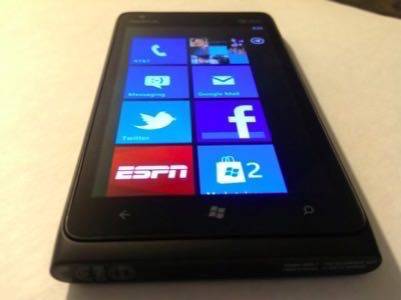

When it hits AT&T stores next week, the Nokia Lumia 900 could be the best smartphone on the market. If Apple released a piece of hardware as sleek and beautiful piece as the Lumia 900, the world would bow at its feet and marvel at Cupertino’s latest masterpiece. But that is not going to happen with the Lumia 900.
The key phrase here is “could be.” As it turns out, the Lumia 900 is not actually the best smartphone on the market. Sure, there are tons of things to like about the device – the raised screen, its perfect size, the one-piece polycarbonate body, the sweet camera – but there is something that holds the device back that is hard to get over. This should have been Nokia’s Hero Phone. Sadly, it isn’t.
Putting the Lumia 900 Through Its Paces
So we understand exactly what we are talking about, the Lumia 900 has a 4.3-inch screen on the diagonal with a 1.4 GHz processor, 4G LTE from AT&T, Wi-Fi, an 8-megapixel back camera and a 1-megapixel front camera. Its body is .45 inches thick, 2.7 inches wide and 5.03 inches tall. It weighs 5.6 ounces and promises 300 hours of stand-by time on 3G and seven hours of talk time.
The hardware itself is what puts the Lumia 900 in the discussion as the best phone on the market – especially the well-engineered polycarbonate body. Nobody makes smartphone bodies like Nokia, and this may be the device’s biggest competitive advantage. Thin and compact with just enough weight and solidity, it’s a joy to hold. Compared to the plastic backs of many Android devices, the Lumia 900 feels like a Swiss watch. If you have held a Lumia 800 (not likely if you are in the United States), you know what we are talking about.
The next greatest aspect of the Lumia 900 is its 4G LTE service. Say what you want about AT&T, Verizon or any other U.S. wireless carrier, LTE as a standalone technology is amazing. Properly implemented, as it is in the Lumia 900, LTE’s speed makes apps and websites extremely responsive and sends even large email attachments almost instantly.
(We did experience one hiccup with AT&T’s LTE. We tried to download the game Plants vs. Zombies over the data connection but were told that the file for the app was too big to download over a data plan and must be downloaded over Wi-Fi. We could not override the prompt and had to connect to a Wi-Fi network. This is not something you see often from Google Play or the Apple App Store. It is hard to tell where that restriction is coming from. It could be directly from the Windows Phone Marketplace or a parameter instituted by AT&T.)
Both cameras on the Lumia are impressive. There is a button on the side of the device that can be dedicated to the camera and acts as a de facto shutter. That is not a new feature for a smartphone but it is well implemented on the 900. Here are a couple of test shots:


Those shots were taken in sunlight. The Lumia 900 doesn’t handle low light conditions quite as well, which makes us wonder about the receptor. The front-facing camera, meanwhile, is completely adequate for what it is. Here is an example of the front facing camera in nominal lighting conditions:

Now for the screen. As a piece of hardware, there is nothing wrong with the Lumia 900’s AMOLED ClearBack glass touchscreen, raised above the body ever so slightly. It fits in well with the polycarbonate body and is one reason the device feels so nice to hold. Yet, if the eyes are the windows to the soul, the screen on the Lumia is the window to … Windows Phone.
Implementing Windows Phone
For any smartphone, the hardware needs to be able to support the operating system. For the most part, this is not a problem for the Lumia 900. The LTE helps apps and websites run fast and render well. Location services such as the preloaded “Local Scout” accurately find your position and recognize nearby businesses.
Microsoft learned from the follies of early versions of Android and realized that if different OEMs are going to produce Windows Phone devices, then the design needs to have guidelines and be streamlined. The “Hubs and Tiles” of Windows Phone have a standard ratio, and all app and device design is centered around the tiles concept. Microsoft’s design principles make the experience consistent from one device to the next.
Nokia and Microsoft worked very closely together to mesh the operating system to the hardware. It is often difficult to tell where Microsoft starts and Nokia ends, much to the credit of both companies. Nokia runs its own version of maps and location services while Microsoft’s Bing is the default search engine. AT&T also gets in on the act with several “bloatware” applications such as AT&T Radio and U-Verse, but these can be easily uninstalled by the user.
The fundamental question to ask about the Lumia 900 is if the hardware supports the operating system to the satisfaction of user expectations. The answer to that is an unequivocal yes.
The Response Test
Whenever we get a new test device, one favorite test is to hand it to people and see how they interact. Can they find the on/off button? How do they react to the home screen? This works best with a range of consumers over a period of several days to get different levels of reaction. One day it might be a group of developers that know exactly what they are looking at and go to key areas of the device. The next day we’ll get reactions from a local bartender who is not technologically savvy. After that it’s time to give it to a friend who is familiar with various smartphone operating systems but may not fall in the realm of enthusiast.

The developers who looked at the phone marveled at the form factor and then went on to pick out various flaws with Windows Phone. The uninformed bartender held the phone and said, “Wow, this is really cool,” and proceeded to click on all of the tiles. The knowledgeable friend played with it for a couple of minutes, handed it back and mumbled, “Why would I give up my iPhone for this?”
It’s a legitimate question. Perhaps even the most important question.
The answer is that unless you are absolutely in love with the Windows Phone interface, there is little reason to dump an iPhone or a high-end Android device for the Lumia 900. Exceptional phones make people want to switch carriers just to get their hands on them. The iPhone is such a device; the Galaxy Nexus is another.
The Lumia 900? Not quite.
Instead, this beautiful piece of hardware is the quintessential Windows Phone device. At $99, AT&T will sell plenty to consumers looking for great hardware at a reasonable price. Is anyone going to ditch a new Android or iPhone for it, though? Not likely.
This is the reason that the Lumia “could” be the best smartphone on the market right now. It has all the elements of a Hero Phone and is the key to Nokia’s salvation and re-entrance into the U.S. market.
But while Windows Phone looks cool and is functional, the smartphone-buying populace of North America has been conditioned toward the apps-plus-home-screen design shared by iOS and Android. Windows Phone’s “Hub and Tiles” seem strange and uncomfortable to many people. Overall, the best smartphone on the market is the one that people actually want to use. And that smartphone does not run Windows Phone.
So, the Nokia Lumia 900 could be the best smartphone on the market. If it was running Android. If it was running iOS. But running Windows Phone, the Lumia 900 is just another piece of stunning hardware.









